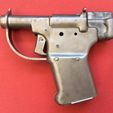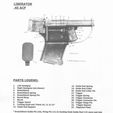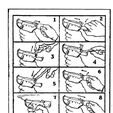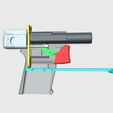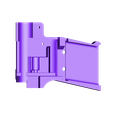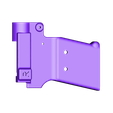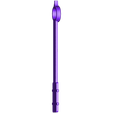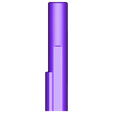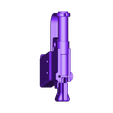This is a Historical Replica & does not fire anything although the hammer can be cocked and fired, there is no firing pin and the chamber has been made smaller so no round can be chambered or fired, its only a toy for big boys ;)
These guns cost $2.10 a pop @ the time of production
Origins of the FP-45 single-shot pistol place it as an initiative by the US Army, intending to arm clandestine and resistance forces within enemy-occupied territories across Europe and spawn liberation of nations from within, using their own motivated civilian populations. The pistol was a direct product of the Army's US Army Joint Psychological Committee findings and the general designation of "FP-45" was derived from the formal designation of "Flare Projector Caliber 45" (also the "Flare Pistol M1942"). This deliberate mislabeling was intended to mislead prying eyes and ears into thinking the weapon was nothing more than a signal flare gun. The project was developed and completed in just a short span of six months from June to August of 1942 - this also encompassing the eleven weeks of required production - and the US Army eventually turned over the reins to the Office of Strategic Services (OSS), the forerunner to today's Central Intelligence Agency (CIA). The OSS was formed during World War 2 to conduct operations against the enemy from behind enemy lines and operated from June 1942 to September of 1945. At its peak, the branch employed some 13,000 personnel. Needless to say, the OSS was sold on the Army's resistance pistol concept.
The FP-45 was designed from the outset as a cheap-to-produce, easy-to-use pistol meant for mass production. It was an implement suitable for close-in work and was intended to promote insurgencies where possible, adding a new internal threat to Axis occupiers. The idea behind the program was to develop a weapon suitable for air-dropping into enemy-held regions in quantity. Those inclined to resist Axis forces on the ground could then recover the weapon package and make use of the smallish pistol by incapacitating a lone enemy individual. This then freed the said enemy's weapons for the taking. Over time, it was seen that a resistance movement would grow in number by an emboldened civilian congregation, stocking themselves with proper, frontline Axis weapons thanks to the FP-45.
The pistol was made available from 1942 to 1945 with production handled by the Guide Lamp Corporation Division of GMC out of Anderson, Indiana. It is thought that some 1,000,000 pistols were ultimately produced and the system went on to be known under the names of "Liberator", "OSS Pistol" and "M1942 Pistol". Each gun was delivered with a 12-step, visual instructional pamphlet to help the operator along. This was an interesting facet in itself for the use of pictures in the instruction set ensured no language or literacy barriers to those in reception of a ready-to-use FP-45 and very litle training in its use was actually required. The pistol - packaged in a clear plastic bag - was also delivered with ten additional rounds of .45 ACP (five could be stored in the pistol grip) and the required wooden dowel to extract spent shell casings.
Design of the FP-45 was highly utilitarian - downright crude some would say - and was characterized by its large, blocky pistol grip. The spring-loaded trigger sat along its front facing and was lightly protected by a curved wire trigger guard. The receiver was slab-sided with the short, smooth bore barrel protruding a short distance ahead, capped by a rudimentary sight post. Construction was largely of stamped metal. In all, the system weighed just 1lb, featured a length of 5.55 inches and a barrel measuring in at 4 inches. The weapon was chambered to fire a single-cartridge of .45 ACP at a muzzle velocity of 820 feet per second with ranges limited out to 8 meters.
The FP-45 operated from a simplistic twist-and-pull breechblock system. The breechblock was manually opened by the user to which a .45 ACP cartridge (the same cartridge utilized in the famous Colt M1911 semi-automatic pistol) was inserted and the breech manually closed. The weapon could now be fired as needed. Once the cartridge was spent, the operator opened the breech once again and forced the spent cartridge out of the chamber using any rod-like device (a wooden dowel rod was provided however) down the barrel. As a single-shot weapon, each cartridge for the FP-45 had to be manually inserted and extracted in like-fashion.
The FP-45 was by no means a frontline assault weapon. As it was meant for use by clandestine units, it was generally utilized (and intended) as an assassination tool. Its accuracy at short range was noted as good for the .45 ACP caliber cartridge - coupled with the generated muzzle velocity - played well in such operations. The barrel, being smooth bore in nature and thusly featuring no internal "rifling", meant that close range work was imperative and directly related to overall accuracy. The lack of rifling itself ensured that the weapon could be easily and quickly produced and assembled without much precision. However, the operator would need to ensure a "first-shot, first-kill" action for reloading of the FP-45 was nothing short of time consuming and awkward.
It is of note that the FP-45 Liberator concept was renewed by the CIA to an extent with the advent of the "Deer Gun" of 1964, intended for use by similar resistance forces during the early phases of the Vietnam War. The Deer Gun bore no similarities in design to the previous Liberator offering and was chambered for the 9x19 Parabellum cartridge. Similarly, the Deer Gun was developed and produced but never issued.
I will publish The Deer Gun next week ;)
Full building instructions will be in the Make
!Don't forget to check out my other Cool designs and Follow my weekly KooKoo uploads, Enjoy ;)

/https://fbi.cults3d.com/uploaders/13409768/illustration-file/e0a8c226-d3c2-4649-b292-e0084fbd87ad/93a5770263eddd3059d5fa6040666fb8_display_large.jpg)









